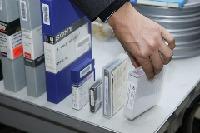Aleksander Gelfand is the Information Management Officer at the United Nations Archives and Records Management Section, Department of Operational Support, United Nations Secretariat in New York.
Digital preservation and media obsolescence have been issues on the minds of archivists at the United Nations since at least the 1970s. Then, information found on punch cards had to be preserved knowing that the cards themselves were not a suitable medium for preserving machine-readable information. A temporary solution was to transfer the information to computer tape, though the process was expensive and time consuming. With the increasingly introduction of new information technologies, preservation seemed a constantly moving target.
The 1980s was a decade of automation at the UN as computers running word processing and database software became ubiquitous. The UN Archives began advocating for action at the very beginning of the lifecycle of electronic records, and as a result Archives staff took a more active role in managing records rather than being a passive recipient. This, however, was easier said than done – at least initially.
The first large wave of digital records came in the form of floppy disks, which were increasingly common in collections accessioned throughout the late 1980s and throughout the 1990s. Frequently inside folders with paper records, unless properly described, these pieces of soon-to-be obsolete media could easily get lost. Nevertheless, by early 2000s, the contents of many of these disks had been migrated to external hard drives and many finding aids included descriptions indicating the presence of this digital media.
While the Archives has been actively working on preserving the information on these floppy disks for decades, the question of accessing and using that data has not always been central to the decision-making process. Frequently, the contents of the disks tended to have drafts of documents of which the final copy existed in printed analog form, eliminating the need to use the digital content itself. The fact that typically UN archives are closed to researchers for 20 years after creation also enabled the delay in having to figure out a way of making these records available.
Over recent years, however, this has begun to change, and in 2019 we were confronted with a high-level, time-critical and sensitive research request to see the contents a large collection of floppy disks from the early 1990s. There were dozens of disks, the contents of which we had successfully migrated to new storage media about ten years ago and had expected to be able to use with relative ease. However, when we tried to open the files, we discovered that many of the file formats were obsolete and could not be opened. Without any emulation software in place, we had to improvise to provide access. We figured out what the different formats were and managed to open the text files using a simple notepad software. We were able to use Microsoft Excel to open the database files. Access copies were created by saving the files via these programs. Although the resulting formatting made it hard to read certain parts and some special characters could not be displayed, the researchers were able to extract the necessary information and came away satisfied.
This experience shouldn’t surprise any of us. Indeed, it is exactly the sort of thing that archivists have been warning us about and preparing for a generation now. Although we’ve been working toward comprehensive digital preservation our biggest challenge remains resources. A former colleague once described our work in this area as a cottage industry, and he was spot on. The work we’ve been doing making multiple copies, and running checksums, migrating from one storage medium to another, creating digital asset registers, is all well and good, and likely allowed us to pull anything useful off those disks at all, but it is still a far cry for a managed and funded digital preservation programme. This is where our work lies now and addressing the access part of it is central.
